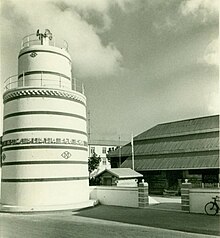Malé Friday Mosque
| Malé Friday Mosque | |
|---|---|
މާލެ ހުކުރު މިސްކިތް | |
 Male Friday Mosque minaret | |
| Religion | |
| Affiliation | Islam |
| Rite | Sunni / Sufism |
| Location | |
| Location | Malé, Maldives |
| State | Kaafu Atoll |
| Territory | Malè |
| Geographic coordinates | 04°10′41″N 73°30′45″E / 4.17806°N 73.51250°E |
| Architecture | |
| Style | Traditional Maldivian architecture |
| Completed | 1658 |
The Malé Friday Mosque or the Malé Hukuru Miskiy (
Master carpenters of the Malé Hukuru Miskiy were Ali Maavadi Kaleyfaanu and Mahmud Maavadi Kaleyfaanu from Kondey, Huvadu.[2]
The calligrapher was Chief Justice Al Faqh Al Qazi Jamaaludheen.[2]
It took 2 years to construct the mosque. In terms of artistic excellence and construction technique using only interlocking assembly, it is one of the finest coral stone buildings of the world.[2]
Location
The mosque is opposite to the Medhu Ziyaaraiy and the
History
The
In 1904, Muhammad Shamsuddeen III (1902–1934) replaced the thatched roof and southern gateway with corrugated-iron sheeting. Further renovations were made in 1963, converting the roof supports to teak wood and replacing the corrugated-iron sheeting with aluminium. In 1987 and 1988, an Indian team from the National Research Laboratory for Conservation of Cultural Property and the National Centre for Linguistic and Historical Research in Malé did conservation work on the mosque.[1]
The mosque has been in continuous use since it was built.[1] The mosque was reportedly built over an ancient temple which predated Islam; the original temple faced the setting sun, rather than Mecca.[4]
-
Sultans' Tombs, Malé Friday Mosque
-
Woodcarving inside Male' Friday Mosque
Features
The Malé Friday Mosque is oriented west. Its prayer carpet is angled towards the mosque's northwest corner, so worshippers can face Mecca while they pray.[4] Devotees enter the mosque from either of the two entrance gates that lead to the mosque's dhaala.
It has intricate carvings,
The mosque's adjoining large, round blue-and-white minaret (built in 1675) resembles a wedding cake,[6] with a wide base similar to a ship's funnel. Built of coral stones, it is braced with metal strips.[1] The minaret is surrounded by a graveyard with carved coral tombstones[5] distinguishing males, females, sultans and their families. Women's tombstones have rounded tops; men's have pointed tops, and inscriptions for royalty are gilt. For family members, small mausoleums with intricately-decorated stone walls were built.[4]
This mosque and the other Maldives coral mosques were added to the cultural
Lacquerwork details
References
- ^ a b c d e f g h i "Coral Stone Mosques of Maldives". UNESCO Organization. Retrieved 10 November 2015.
- ^ ISBN 9780986281846.
- ^ a b West 2009, p. 493.
- ^ a b c d e Masters 2009, p. 97.
- ^ a b Chesshyre 2014, p. 170.
- ^ a b c "Malé Hukuru Miskiy (Malé Friday Mosque)". fodors.com. Retrieved 10 November 2015.
- ISBN 84-7254-801-5
Bibliography
- Chesshyre, Tom (27 November 2014). Gatecrashing Paradise: Misadventures in the Real Maldives. Nicholas Brealey Publishing. ISBN 978-1-85788-937-6.
- Masters, Tom (2009). Maldives. Lonely Planet. ISBN 978-1-74179-013-9.
- Neville, Adrian (1 January 1995). Malé, Capital of the Maldives. Novelty Printers and Publishers. ISBN 978-99915-3-018-5.
- West, Barbara A. (1 January 2009). Encyclopedia of the Peoples of Asia and Oceania. Infobase Publishing. ISBN 978-1-4381-1913-7.
- USA, IBP USA (1 January 2012). Maldives: Doing Business in Maldives for Everyone Guide – Practical Information and Contacts. Lulu.com. ISBN 978-1-4387-7268-4.















